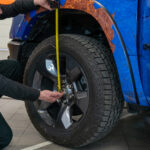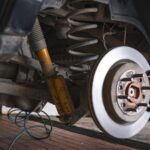
Quality of handling after a lift. Does raising the suspension affects ride comfort?
A suspension lift will always impact the driving experience. After all, you’re probably doing it to change how your off-road vehicle handles. However, have you considered that off-road driving and regular driving prefer different handling characteristics? Keep this in mind when modifying your car and learn how to maintain or increase driving comfort in every situation, even after a lift.
Quality of handling after a lift. Before you raise the suspension
A suspension lift will also affect daily driving on local roads or asphalt. It’s not a secret. Many inexperienced drivers test their freshly modified off-road cars and are surprised by the changes. Is the experience better or worse? How does the quality of handling change after a lift? It’s subjective, but we can confidently say that the suspension’s behavior will differ significantly from what you’re used to.
Before rushing into a lift installation, ask yourself why you need it and how much you’re willing to invest. If it’s purely for an eye-catching look, it might not be an investment for you.
However, if you have the financial and time resources for a proper suspension upgrade, you can achieve driving comfort regardless of the lift height with the right combination of components. What does this mean in practice?
What affects comfort while driving
Let’s examine what truly influences driving comfort, specifically the stiffness or softness of the suspension. Mainly, springs and damping components play a crucial role, as they absorb road irregularities and manage the energy that impacts the car’s body. In other words, they determine how comfortable you are in the driver’s seat. So, if you are raising the suspension, it’s important to pay close attention to the springs and shock absorbers.
read more
Installing a lift changes the vehicle’s center of gravity and weight distribution. This shift puts additional stress on the springs, causing them to compress more. How much this affects you depends on the driver and the vehicle.

A lifted vehicle tends to have a greater tendency to roll, and adding extra weight, such as a loaded trunk, can overwhelm the stock springs, reducing their effectiveness. This can result in what’s commonly known as body sway, making driving more challenging, especially during turns.
Therefore, the vehicle’s weight plays a crucial role in selecting the right springs or leaf springs. If these components are not properly matched to the load, they may not operate within their full range of motion, leading to reduced vibration absorption. That’s why springs in suspension lift kits are generally stiffer. Stiffer springs can decrease flexibility and make you feel changes in the road surface more intensely.
What are progressive springs?
Apart from matching the springs to the vehicle’s weight, the design of the spring coils also significantly affects driving comfort. Progressive springs, for instance, offer variable performance with stiffness that increases under load.
Unlike standard linear springs, progressive springs have tighter coils in the initial phase of compression. This initial flexibility allows them to better absorb minor road imperfections, resulting in smoother and more comfortable driving.
The remaining section of the progressive spring is stiffer and has wider coils providing better support for the vehicle’s weight and enhancing stability. This part of the spring engages during deeper compression, such as when hitting large bumps or obstacles.
Related articles
Quality of handling after a lift, or why you shouldn’t skimp on shock absorbers
Another option for reducing the stiffness of a lifted suspension—or, in other words, increasing driving comfort—is using shock absorbers with two-level compression adjustment. Slow and fast compression rates describe how quickly the shock absorber operates (i.e., how fast its piston moves) at a certain stroke level under specific conditions.
Slow compression occurs when the vehicle moves at low speed over large bumps or during suspension dives when braking hard. Fast compression happens when driving over small bumps at high speeds, where the impact on the shock absorber is quicker but less intense.
Adjusting the shock absorber’s compression allows you to customize driving comfort depending on the terrain and driving style. Increasing slow compression helps prevent the suspension from harsh bottoming out. This is useful if the suspension feels too soft after a lift. Conversely, decreasing fast compression allows the suspension to better absorb small bumps, resulting in a smoother, more efficient, and flexible ride. Standard shock absorbers don’t offer these options.
Does taller mean stiffer? Conclusion
In conclusion, lifting suspension will definitely change vehicle’s performance. This could mean that your off-road vehicle becomes less agile in turns and more sensitive on rough terrain. Alternatively, it might feel more like a boat or a tank, depending on the car brand, lift height, and your personal comfort preferences.
You might think that since lift kits include stiffer suspension components, they should compensate for the raised center of gravity. However, reality is never that simple. This doesn’t mean you need two cars—one for off-roading and one for daily driving—to feel comfortable behind the wheel. That’s when experienced experts from Offroad Express come in. They are highly skilled at selecting the right suspension components for you, ensuring you always enjoy your ride, no matter the circumstances.









Comments ()